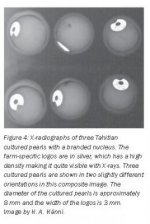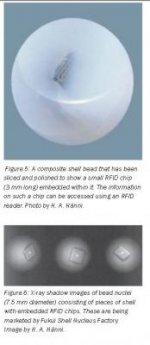It would definitely be too costly to slice the nucleus in half, put the chip in and then reattach. The concept is based on "imparting the identity before it is even born." In other words, when the nucleus is produced, the chip was already there. Other than the lamination technique, I see no other methods that can cost-effectively and efficiently produce this.
Due to the economies of scale in terms of production and natural resources, those of who cultivate large pearls will get the greatest cost benefits. Laminated nucleus production greatly lowers the demand for large, rare and expensive raw materials while sustain the supply of large nuclei. So, it will be a give-and-take between sticking to the Japanese's desire for one whole bead or conserving the environment by using the raw materials more efficiently. Anyway, in short, large pearl nuclei will be a lot cheaper than the traditional ones. This goes for the same for the ID nuclei.
The only way to really track movements is by using active RFID. Passive RFID chip is used in this case, thus it emits no signals unless a communicator is nearby. Furthermore, the readability is only in centimeters. No one can track your movement.
The ultimate purpose is to solve three things - identification, track-and-traceability, authentication.
Even if you buy from a brand name store or get the pearl certified by a reputable gemological lab, no one on this planet can 100% guarantee your pearl's authenticity. The only way you know it is truly 100% guarantee authentic is by getting the pearl from the pearl farm yourself. Indonesia or Myanmar pearls sold as Australian pearls. Akoya pearls mistreated as unbeaded Chinese freshwater pearls. Unknown source for the pearl nuclei but only later to find out that they are tridacna (giant clam) or chemically-treated. Pearl jewelers want to brand their pearls. The pearl certificate has no value since it is all based on observable characteristics (and the nucleus).
Even if you can tell where the pearl is generally from, which specific location is it from? When was the pearl nucleus implanted? When was the pearl harvested? Who was the technician who implanted the nucleus?
Nevertheless, the chip itself is meaningless unless you wire it to a database. And the database is not credible unless an international standard is established for track-and-trace and authentication.




